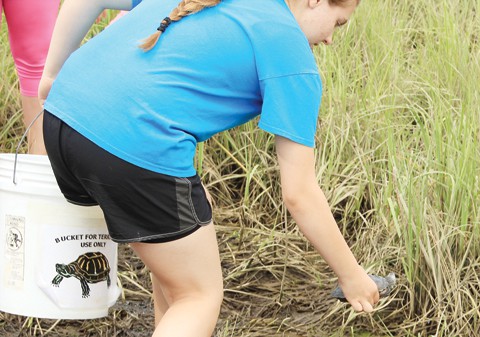Return of the Terrapins
With their feet gingerly navigating mud and grasses at the water’s edge as they prepare to release three baby northern diamondback terrapins into the wild, these Severn River Middle School students could be almost anywhere along Chesapeake Bay.
Poplar Island, however, is no ordinary locale. The island, like the careful return of the terrapins to their birthplace, is a unique and successful example of environmental stewardship. Visiting there, students are in position to understand our human impact, both positive and negative, on the world around us.
Getting to an Island
“You can really see the differences over the years. It is amazing,” says sixth-grade science teacher Alice Hudson as MV Terrapin approaches relatively low-lying Poplar Island.
On board are the students, two teachers, one lone chaperone — this interested father — and baby terrapins Coconut, Pineapple and Twix.
Teachers Hudson and Eric Greenlee have been bringing students, and turtles, to Poplar Island for nearly 15 years.
Organized by Anne Arundel County’s Arlington Echo Environmental Literacy and Outdoor Education program, turtle raising and releasing has become a mainstay on the academic calendar for elementary and middle schools across the county. At the start of the school year, nearly 200 young turtle hatchlings from Poplar Island are gathered and distributed to classrooms. By late spring, two to three school groups a day visit the island to return the young turtles to their home. Severn River Middle was the last of this year’s release trips.
Cormorants skim the surface of the Bay en route to an island that is becoming popular for native fowl. Many osprey nest on platforms, and hundreds of other birds circle and dive.
Heavy-duty construction equipment is still at work, recreating the island. Against that backdrop, Maryland Environmental Service staff introduce each class of terrapin raisers to this massive ecosystem restoration project.
Once an 1,147-acre home to a small community with families, a school and post office, Poplar Island was abandoned in the 1950s. By 1993, only a series of small points of land totaling three to five acres remained. The island disappeared because deforestation left the weather and waters of the Chesapeake free to erode the habitat of both humans and animals.
Now, nearly 20 years into a five-decade undertaking, Poplar Island is coming back to life, thanks to coordinated local, state and national efforts. Megan DiFatta, who has hosted school groups for six years, explains that the island is being built largely from dredged material. Each year, millions of tons of sediment are dredged from ports to clear the path for boats and ships like the container ships we’d seen crossing beneath the Bay Bridge.
The dredged sediment moves by barge to Poplar Island to be reused as soil to create upland forested areas and intertidal wetlands. Channels are carved into the land, creating a natural habitat for animals like the turtles that must struggle to compete with shoreline development along the Bay.
A Turtle Sanctuary
Along the constructed beach, DiFatta points to a turtle nest. It could well, she says, be the work of turtles reintroduced to Poplar after being reared by school groups like ours. Some of the students on this trip are also return visitors to the island, having raised and returned turtles in earlier grades.
Without protection, the thousand or so small hatchlings born each summer will struggle to survive. Classroom-raised reptiles have a better chance of survival, DiFatta says, because their size makes them less susceptible to predators. The “cheeseburger”-sized turtles the Severn River Middle School students bring are not as easily consumed by herons or gulls as their “potato-chip”-sized siblings that remained on the island since hatching.
Their turtles are larger, the sixth- and seventh-graders know, because of a steady diet and no need to hibernate in the classroom. They get “lots of love,” one exclaims to a chorus of giggles.

After scanning the microchips implanted in the turtles so they can be tracked, DiFatta, Hudson and Greenlee lead the kids toward the water. The teens snap photos with their phones. Then, with playful farewells, they lower the buckets to release their terrapins.
Returning Coconut, Pineapple and Twix, the kids reach the heart of their lesson. Seeing, hearing and experiencing the progress of Poplar Island’s restoration to habitat sustainability, they begin to understand how conservation, rising from their love of nature, is critical for the survival of their turtles, the Bay and the planet. We humans can destroy the land, as happened to clear-cut Poplar Island. Or we can learn to be stewards of the land and water.
